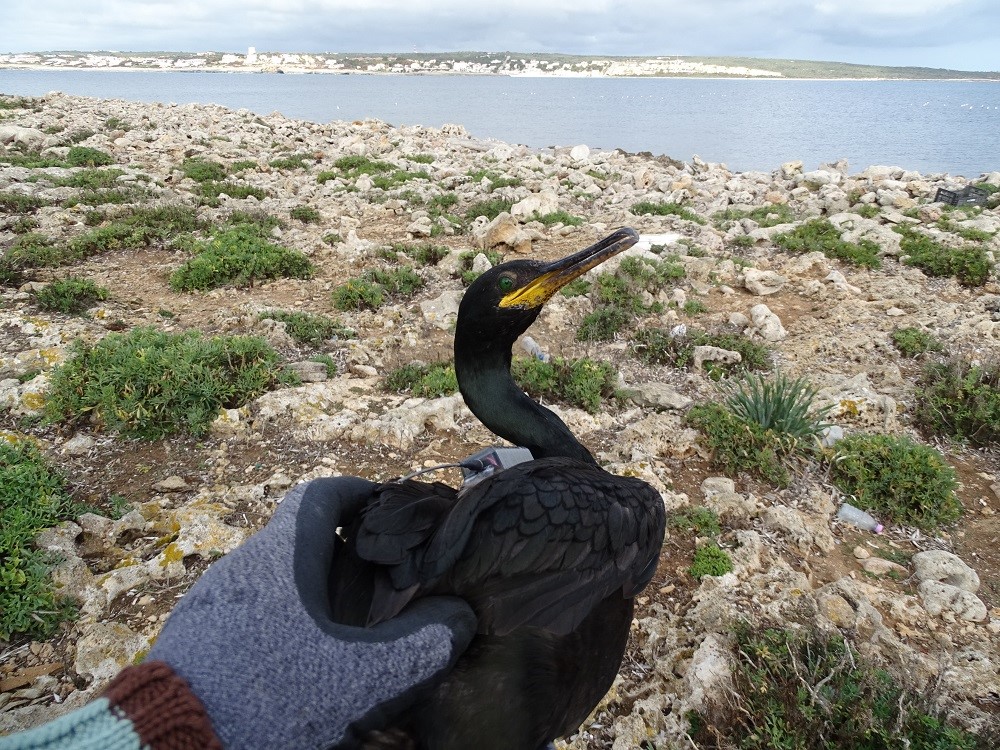03-04-2020
GPS technology to study the movements of the European Shag on the Eastern coast of the Iberian Peninsula and Balearic Islands
A total of eight Eurpean shags (Gulosus aristotelis) have just been tagged with remote monitoring devices in two locations along the Mediterranean coast, specifically in Isla Grosa (Murcia) and Illa de l'Aire (Menorca). This action has been undertaken by experts from the Faculty of Biology and the Institute for Research on Biodiversity (IRBio) of the University of Barcelona in collaboration with the Asociación Naturalista del Sureste (ANSE), within the framework of the AMARYPESCA project directed by Professor Jacob González-Solís and coordinated by researcher Virginia Morera, members of the Department of Evolutionary Biology, Ecology and Environmental Sciences of the UB.
The project, funded by the Fundación Biodiversidad with the support of the European Maritime and Fisheries Fund (EMFF), aims to evaluate the effectiveness of the Spanish Network of Marine Protected Areas and to propose measures to improve fisheries and aquaculture management and the conservation of pelagic and coastal seabirds in the Canary Islands and the Spanish Levante. Within the framework of the AMARYPESCA project, research in the Mediterranean will focus on the European shag (Gulosus aristotelis), the Yellow-legged gull (Larus michahellis), the Audouin's gull (Larus audouinii) and the Scopoli's shearwater (Calonectris diomedea). In the Canary Islands archipelago, the populations of Cory's shearwater (Calonectris borealis) and Bulwer's petrel (Bulweria bulwerii) will be monitored.
One of the most emblematic coastal birds of the Mediterranean
The European shag - one of the most unique seabirds of the Mediterranean - is a species affected by the interaction with human activities in the marine environment (by-catch, sport fishing, etc.). Despite being classified as vulnerable in the National Catalogue of Threatened Species, this species is not covered by any conservation plan as indicated by the legislation. In relation to the ecology of this marine species, there are still many unknowns about its feeding areas in the Mediterranean.
The experts want to assess whether the species' feeding areas are within the Spanish Network of Marine Protected Areas (RAMPE), which also includes the Special Protection Areas for Birds (SPAs). Another fundamental objective of the study is to determine the factors that modulate the interaction between these seabirds and the artisanal fishing fleet and aquaculture, activities that are widely developed in the western Mediterranean.
Remote monitoring technology to study the pattern of bird movements
As part of the project, UB-IRBio experts will study the pattern of bird movements by placing GPS devices combined with mobile technology, which allows them to receive their positioning in real time. The expert Ángel Sallent (ANSE) has just deployed eight devices on shags from Isla Grossa (4) and Illa de l’Aire (4). Among other data, the remote monitoring technology will make it possible to know the position of each individual every fifteen to sixty minutes.
The trajectories of the last days of the birds tracked in both locations can be seen in these interactive maps in high resolution (each animal with a different colour, https://tinyurl.com/rev7f7p)
This information will be crucial to determine their main feeding areas (aquaculture farms, small-scale fishing areas, coastal areas, etc.) and whether these fall within the marine regions included in the RAMPE. The Spanish Institute of Oceanography (IEO) is also collaborating in this activity, a partner providing data on the location of fishing vessels for the spatial-temporal characterization of the fishing effort of each fleet and the determination of the areas at greatest risk of interaction with sea birds.
The experts Leia Navarro and Raül Ramos (UB-IRBio), Ángel Sallent (ANSE) and Salvador García (IEO) also participate in the AMARYPESCA project, which is supported by the Fundación Biodiversidad (Ministry for Ecological Transition and the Demographic Challenge and Ministry of Agriculture and Fisheries, Food and Environment), through the Pleamar programme of the European Maritime and Fisheries Fund (FEMP). The General Directorate of Biodiversity and Environmental Quality of the Ministry for Ecological Transition and the Demographic Challenge (Isla Grosa) and the Island Council of Menorca (Illa de l’Aire) have also collaborated in the recent tagging of European Shag.
